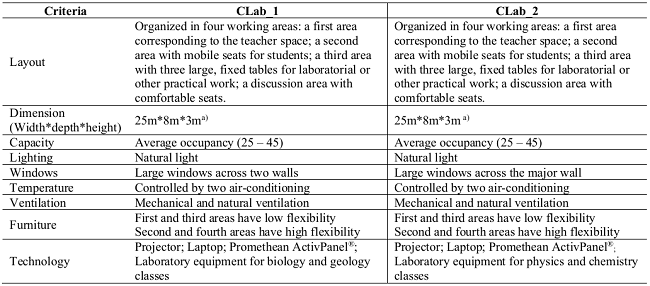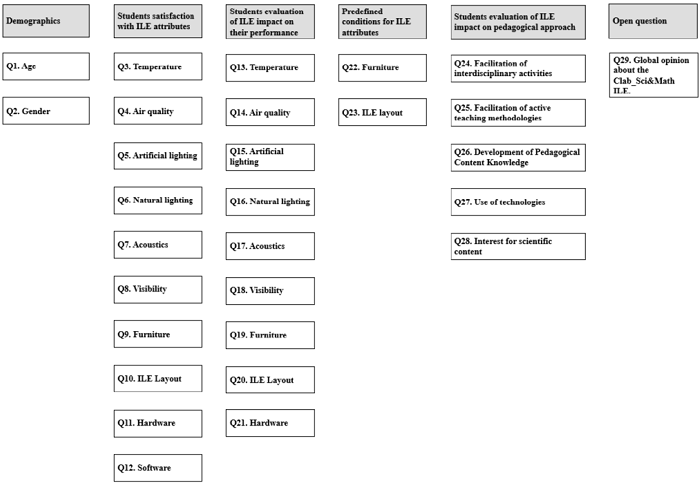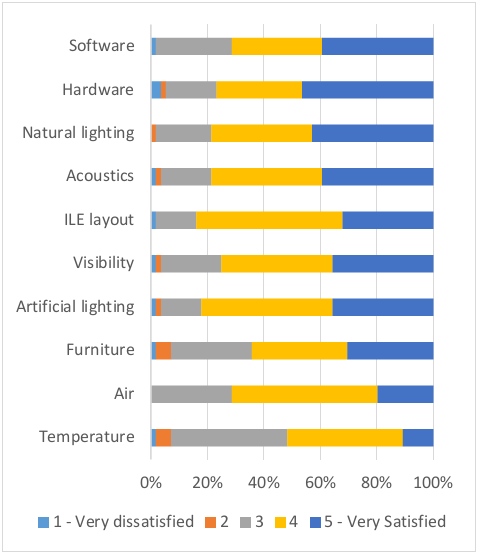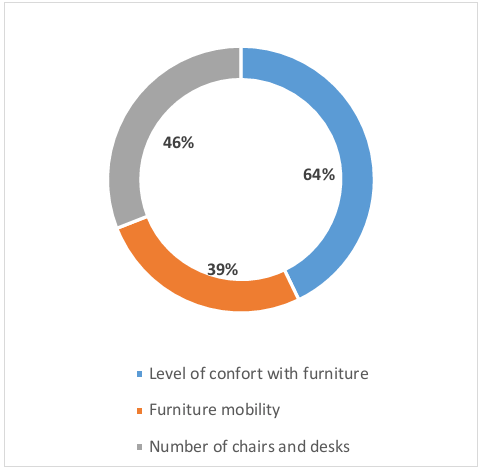INTRODUCCIÓN
The scope of this study is on learning spaces in higher education. The impact of innovative learning environments (ILEs) on students' satisfaction and performance has aroused high research interest in recent years. The influence of learning environments in the educational programs, practices, and students' learning in the 21st century is a problematic that requires deeper understanding, as showed by the review done by Cleveland and Fisher (2014). In the early years of the 21st century many countries invested in the transformation of the pedagogical practice through the creation of new designs for school buildings (Daniels et al., 2009). Universities are also facing challenges that put pressure in the creation of learning environments better suited to students' needs (McCune & Entwistle, 2011), and more flexible learning opportunities (Valtonen et al., 2020). Some of those needs are related to learning environments and teaching practices able to support the development of 21st century skills (Valtonen et al., 2020). The initiatives related to the change of educational spaces followed some guidelines that were summarized in the ILEs principles of the Organization for Economic Co-operation and Development (OECD) (2017).
The ILEs approach is also carving its path in higher education. In many institutions of higher education, traditional lecture classrooms are being replaced by active learning classrooms, which are designed to facilitate student-centred instruction (Clinton & Wilson, 2019). This movement is also occurring in many teacher training institutions, which are transforming their spaces into more flexible and technological enriched environments. Nissim et al. (2016) stated that an ILE could have a significant influence on pre-service teachers' motivation. For instance, the ITELab (Initial Teachers Education Lab) project, co-ordinated by the European Schoolnet, aimed to develop new approaches to integrate ICT on ITE courses under the umbrella of the Future Classroom Lab (FCL) project. FCL published guidelines for creating or adapting learning spaces in innovative ways by rethinking the role of pedagogy, technology, and design in classrooms. Therefore, following these European initiatives about ILEs in higher education, the School of Education of the Polytechnic Institute of Santarém initiated a project, named CreativeLab_Sci&Math, in 2016. The focus of the project is innovation in science and mathematics teacher education, within the framework of ILEs principles (Cavadas et al., 2019). The main guideline of this project is that educational innovation and development can emerge through the change of spaces, according to the suggestion of Daniels et al. (2019).
Recent research has shown that ILEs have an impact on the way students of primary, elementary, and secondary schools learn, and indeed could promote pedagogical change (Mahat & Imms, 2020; Merriënboer et al., 2017; Mulcahy et al., 2015) related, for instance, to the use of more active teaching methodologies (Merriënboer et al., 2017). For example, in a study about the influence of design on the perceptions and actions of students and teachers at four UK schools, Daniels et al. (2019) have shown design offers a range of possibilities that invites pedagogical transformation, when design and practice are aligned. The creation of ILEs in higher education settings has also motivated researchers to study the effectiveness of learning spaces in supporting the learning process (Cleveland & Fisher, 2014; Temple, 2008). However, the impact of ILEs in pre-service teachers' education is less understood, although they face various challenges in their practice when they are placed in schools with ILEs (Nelson & Johnson, 2021), including teaching anxiety (McMinn & Aldridge, 2020). Besides, several studies focusing on school climate or school environment, a broader construct (e.g., Kearney, et al., 2020; Lombardi, et al., 2019; Tapia-Fonllem, et al., 2020), have shown that school facilities have an impact on students' well-being, engagement in school activities and academic achievement. Therefore, to better understand the impact of ILEs on higher education students, a research field with little expression in Portugal, this study aims to answer the following research questions, in the wake of work by Yang et al. (2013): How do higher education' students perceive the physical space, the technological and the pedagogical attributes of an innovative learning environment? What impact do they perceive about those innovative learning environment features on their performance?
THEORETICAL FRAMEWORK
Research About Learning Spaces in Higher Education
While learning environment is an expression used to refer to the social, psychological, or conceptual environment where learning occurs, learning space refers to the physical environment or space where learning occurs (Cleveland & Fisher, 2014). For the purpose of this study, the learning space follows the Cleveland and Fisher (2014) approach, which considers it a physical space, and not an online or blended learning environment, an approach followed in other studies (e. g. Yilmaz & Malone, 2020). The participants in the working group of the OECD (2006) which evaluated quality in educational facilities defined learning space as:
a physical space that supports multiple and diverse teaching and learning programmes and pedagogies, including current technologies; one that demonstrates optimal, cost-effective building performance and operation over time; one that respects and is in harmony with the environment; and one that encourages social participation, providing a healthy, comfortable, safe, secure and stimulating setting for its occupants. (pp. 1-2)
Many initiatives were developed concerning the evaluation of learning spaces, associated to the development of new buildings to support innovative approaches to teaching and learning practices (OECD, 2009). There are many definitions of ILEs in the specialized literature; however, for the effects of the present work, an ILE is intended as the “product of innovative space designs and innovative teaching and learning practices” (Mahat et al., 2018, p. 8). According to Borba et al. (2020), flexibility, technology, furniture, natural elements, and environmental aesthetics are attributes that should be considered when designing spaces for learning. Those initiatives associated to the change of educational spaces followed some guidelines that were summarized in the innovative learning environments principles (OECD, 2017). Those principles focus on social and active learning methodologies in different spaces, in which learners' motivations, emotions, and prior knowledge are considered. An ILE should provide learners with challenging interdisciplinary activities and formative feedback to support learning.
University, learning, and space are intimately connected (Temple, 2008). The research about higher education spaces focuses on the impact of technology on space use, campus design, specialized spaces and the relation with learning spaces and the development of a university community (Temple, 2008). In fact, the relation between spaces and learning in higher education is a rich field of research, albeit complex and not well-understood (Cleveland & Fisher, 2014; McNeil & Borg, 2018; Temple, 2008). One challenge is that the study of higher education spaces and their influence on teaching and learning is a methodologically difficult area (Temple, 2008) and lacks evaluation approaches. Cleveland and Fisher (2014) stated that the creation of evaluation approaches or tools for assessing the effectiveness of physical learning environments in supporting teaching practices must be flexible. These evaluation approaches should also accommodate the specific physical settings and social contexts within which they are going to be applied. For that reason, McNeil and Borg (2018) created a framework to shed light on connections between space, teaching and learning. In the proposed framework, the authors relate space, intended as the socio-political and physical-temporal context, with teaching, subdivided in teaching approach, design and practice. They also represented the inter-relationship between these dimensions in time, presenting a valuable approach to understanding the connections between space, teaching and learning.
The Impact of Learning Spaces in Higher Education' Students
The development of ILEs is part of a broader educational approach whose aim is to engage students in their learning (Brooks, 2011). Therefore, Cleveland and Fisher (2014) have recommended that the research about learning environments should seek the opinions of students because they are the main users of those environments. Another reason is that the perceived value attributed to an ILE is an important component of students' motivation (Clinton & Wilson, 2019).
The evaluation of the impact of classrooms, including ILEs, on higher education students has followed different approaches. One is the evaluation of the impact of classroom attributes on student satisfaction and performance. This approach was followed by Yang et al. (2013). The authors concluded that students' perceptions are focused on spatial attributes, mainly visibility, room layout and furniture, as well as ambient attributes, specifically air quality and temperature. Some of these findings concur with the study by Clinton and Wilson (2019) about students' perceptions of ILEs features. Students valued the furniture, specifically the round tables and the whiteboard space, appreciated the visibility because it allowed them to see their peers during collaborative learning, and the ample space of the ILE. However, the inadequate size of the tables for group work and the uncomfortable seats were criticized by the students (Clinton & Wilson, 2019). The findings of Yang et al. (2013) also indicate that students' perceptions could be influenced by seating locations and other factors, such as classroom size and course time/durations. These previous findings express the potential value of design, management, and maintenance of higher education classrooms (Yang et al., 2013).
Other approaches focused on the influence of ILEs in collaborative learning. About that relation, some studies indicated that higher education students perceived ILEs, or active-learning classrooms, better suited for collaborative learning and group work than traditional learning environments. For instance, Borba et al. (2020) highlighted the importance of the physical space as a factor that connects both students and teachers in an active learning process and contributes to student engagement. Higher education students also manifested a more favourable attitude for collaborative learning in ILEs than in traditional lecture classrooms (Clinton & Wilson, 2019). One reason that justifies this different value attributed by higher education students to collaborative learning in both environments is the fact that ILEs were purposefully designed to facilitate students' collaboration, with movable chairs around round tables (Clinton & Wilson, 2019). This different seating arrangement and classroom layout enabled interactions between the students, and opportunities to move around the space which also promoted students' contact (Clinton & Wilson, 2019). The same results were achieved in Borba et al.' (2020) study, in which students stated that the wheeled furniture allowed more contact with their peers and teachers. Another aspect that students value is informal learning environments in higher education contexts for study or just relaxing (Valtonen et al., 2020). This was the approach followed by Rämö et al. (2019) who transformed the main hallway of the department into a vibrant, collaborative learning workspace between students and tutors. The increasing opportunities for the support of students by teaching personnel were also a feature appreciated by them in flexible learning environments (Valtonen et al., 2020). This could also have other benefits apart from better learning. In fact, McMinn and Aldridge (2020) have shown that a learning environment where students are able to give their opinions and freely discuss ideas with others can reduce learning anxiety.
The impact of the technology present in the ILE on students' performance is also an important field of study (Temple, 2008). For example, Brooks (2001) concluded that students taking a course of Biology in a technology-enhanced environment, outperformed their peers who were taking the same course in a traditional learning environment, keeping the other parameters controlled. Technology was also an aspect highlighted by Valtonen et al. (2020) in whose study students stated the need for learning environments that allow communication and participation without coming to the campus for face-to-face meetings and supportive ICT resources.
Other studies have demonstrated that the flexible layouts of ILEs contribute to motivation to attend class, engagement in class (Nissim et al., 2016), lowering the failing rates (Borba et al., 2020), changes in the social context of the classes (Borba et al., 2020; Nissim et al., 2016), improved 21st century skills, such as creativity (Nissim et al., 2016) and problem solving, increased conceptual understanding (Borba et al., 2020) and ability to achieve higher grades (Nissim et al., 2016) in higher education students.
RESEARCH METHODOLOGY
Research Design
The research design used was an exploratory study (Fraenkel et al., 2012) because it was the most suitable approach to achieve the general goal of this work. The purpose of this study is to contribute to the understanding of the satisfaction of higher education students with the attributes of the CreativeLab_Sci&Math ILE, and their perceptions regarding the impact of these attributes on their performance. Concerning technical procedures, a questionnaire was applied. Questionnaires are useful to present inferences about a population based on information collected from a sample (Swain, 2007). In this case, higher education students' responses to quantitative items concerning the dimensions of an ILE and qualitative data from an open question were analysed. Data analysis was descriptive.
Participants
A total of 56 higher education students participated in the study. Most of the students are female, and their age is mainly comprised between 18 and 21 years. Students were attending an undergraduate programme in Basic Education, a first step to become professional teachers in Portugal. Concerning ethics, all participants were clearly informed of the purpose of the study and authorized the use of their collected data for research purposes, through written informed consent. Participants were informed that their data would be anonymized during data analysis and would remain strictly confidential and used only for the purposes of this research. This study complies with ethical principles of the authors' research centres.
The innovative learning environment features
The higher education students surveyed had the opportunity to have their classes in an ILE named CreativeLab_Sci&Math. This ILE consists of two spaces (CLab1 and CLab2). Both have laboratorial equipment and educational resources, and one is dedicated to biology and geology classes (Figure 1) and the other to physics and chemistry classes. Each space is organized in four main areas. The first one is the teacher area, and includes a whiteboard, a laboratorial table and projection equipment. The second area has mobile chairs facing the board and is used by the students for presentations and to discuss information imparted by the teacher. The third area has three large, fixed laboratory tables, used mainly for laboratorial or other practical activities. The last area, constituted by small tables and comfortable puff cushions, is located at the back of the space and is adapted for discussion and collaboration. This area is quite important, because a learning environment where students are allowed to give their opinions and discuss ideas with their peers can reduce learning anxiety (McMinn & Aldridge, 2020). Cosy, comfortable, and informal learning environments were also valued by higher education students in Valtonen et al.' (2020) study.
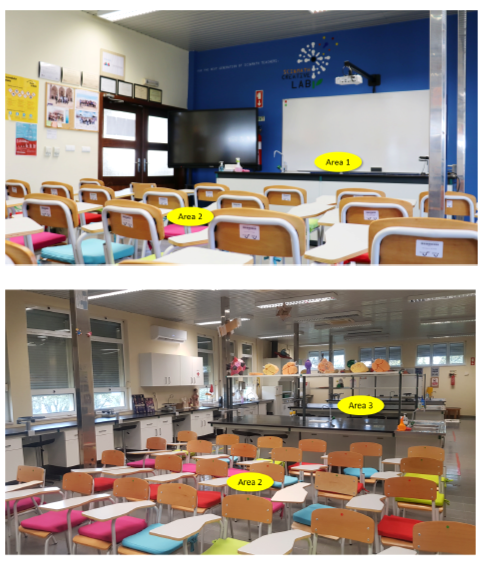
Figure 1. CreativeLab_Sci&Math 1, an ILE dedicated to biology and geology classes (CreativeLab_Sci&Math 2 has a similar layout). The pictures present area 1, with ICT and the teacher space, area 2, where students are usually seated, and area 3, a working area for laboratorial or other practical tasks are visible.
Starting from traditional laboratories, the space of this classrooms has been continuously transformed into an ILE, since 2016. Table 1 presents the specifications of those spaces, using Yang et al.'s (2013) criteria.
Data Collection and Analysis
An online questionnaire was administered to students that regularly use the CreativeLab_Sci&Math, through a Google Form®, in the first semester of the academic year of 2020/2021. The questionnaire was adapted from the one Yang et al. (2013) validated and applied to higher education students. However, knowing that other characteristics of physical learning spaces affect teacher cognition and behaviour (Merriënboer et al., 2017), and therefore how students learn, additional questions were added. The final questionnaire is organized in six sections (Figure 2).
The first section asked students to provide demographics information, such as their gender and age. The second and third sections of the questionnaire focused on students' satisfaction with the ILE' attributes and their perceptions of the impact of these attributes on their performance, using the same Likert scale questions of Yang et al.' (2013) questionnaire. Concerning attributes, students had to assess the environment (temperature, air quality, artificial lighting, daylight, acoustics related to hearing the teacher, visibility concerning the ability to see the visual aids), space (furniture and global layout) and technology (hardware and software) of the ILE.
Students were also inquired about the previous attributes' impact on their performance, according to Yang et al. (2013), excluding software, because in the classes that students attended, they did not use specific software for science learning. According to Yang et al. (2013), respondents were also asked to identify the predefined conditions for ILE attributes, with a focus on furniture and the ILE layout, in the fourth section, selecting their answers from a set of options presented.
An addition to the questionnaire used by Yang et al. (2013) was the evaluation of the ILE' impact on the pedagogical approach experienced by students. They were inquired about their perception of the impact of the ILE on the use of active learning methodologies (such as inquired-based learning approaches), development of interdisciplinary activities, use of technologies, their interest in science subjects, and the development of pedagogical content knowledge (PCK). The definition of PCK presented to them was adapted from the proposed by Loughran et al. (2012): “PCK is the knowledge that teachers develop over time, and through experience, about how to teach particular content in particular ways in order to lead to enhanced student understanding” (p. 7). Since the survey was being applied within an ILE dedicated to science & mathematics education, it was added that PCK is a type of knowledge that goes beyond the domain of scientific content knowledge and requires the domain of pedagogical strategies which facilitate the learning of scientific content.
The final section included an open question about additional comments regarding the ILE. This final question was only applied to second year students because these students have used the CreativeLab_Sci&Math for a longer time in the semester that corresponds to the application of the questionnaire. The questionnaire was applied to students at the end of their science classes.
Data Analysis
The collected data were exported to a Microsoft Excel® worksheet for quantitative analysis, a procedure also followed in other studies (e.g., Prasad & Usagawa, 2014). Data from questions Q1 to Q28 were quantified using a relative frequency distribution. The answers to the open question (Q29) were coded. The open question was not compulsory, and only 25 students answered it. Each of the students was anonymized using a number (S1 to S25). Excerpts from the answers to the open question were used to add more information and clarify the qualitative data. To analyse the qualitative data, an inductive strategy of content analysis was used (Miles & Huberman, 1994).
RESULTS
CreativeLab_Sci&Math attributes
The results of the higher education students' satisfaction with the attributes of the CreativeLab_Sci&Math are presented in Figure 3.
Each attribute of the ILE was evaluated positively (with a rating of 4 or higher) by at least 60% of the participants, except for temperature. The attributes that received the highest rating (5 - Very satisfied) by a greater proportion of participants were hardware and natural lighting. Indeed, both CreativeLab_Sci&Math spaces have enough didactic equipment to support learning activities, such as the ActivePanel®. However, in their open question answers some students also highlighted that the ILE has other resources, in quantity and diversity, which facilitate laboratorial and other activities.
The ILE layout was also appreciated by the students, as shown in this statement: “The CreativeLab_Sci&Math is very useful because it is divided in several areas appropriate for different tasks” (S8). It was considered “excellent” (S3), “interactive” (S7), “dynamic” (S12), “warm” (S16), “innovative” (S22) and “different” (S23).
The CreativeLab_Sci&Math spaces also have large windows across the major walls, which provides enough natural light, a feature appreciated by students. Although the spaces have air conditioning, the temperature was the attributed that caused more dissatisfaction, as in the case of this student: “It's a comfortable, albeit cold environment” (S22). One element that may explain this result is the fact that the spaces were very cold at the beginning of classes, and the survey was applied in the winter. About the furniture, the higher education students were also inquired concerning the predefined conditions for that attribute (Figure 4).
Most students (64%) considered the furniture within CreativeLab_Sci&Math ILE comfortable but highlighted its reduced mobility. One aspect that may explain this perception is the fact that the ILE space has three large, fixed tables for laboratory activities (see Figure 1). Additionally, in classes with a higher number of students, there are not sufficient chairs in area 2 for all (see Figure 1), and they must seat in other areas of the ILE. Three students commented that the chairs are uncomfortable for writing: “The feature that I least like are the chairs because they are not suitable for writing” (S19) and sitting for long periods of time: “the seating places were small” (S24).
The impact of the CreativeLab_Sci&Math on students' performance
The results of the students' evaluation of the impact of the CreativeLab_Sci&Math ILE attributes on their performance are presented in figure 5.
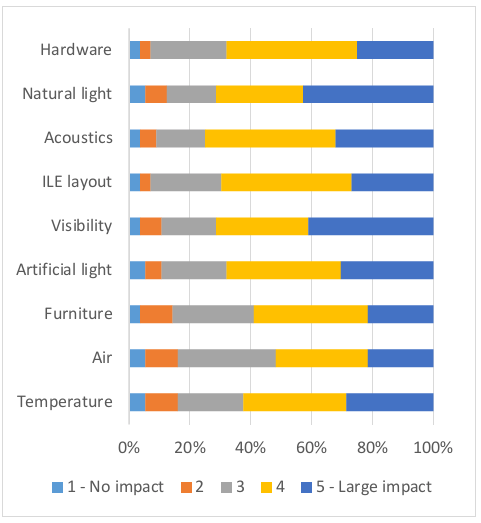
Figure 5. Higher education students' evaluation of the impact of the attributes of the CreativeLab_Sci&Math on their performance.
The impact of each one of the ILE attributes on students' performance was evaluated with the highest ratings (4 and 5) by at least 60 percent of the participants, except for furniture and air. The two attributes that received the highest rating (5 - Very satisfied) by a greater proportion of participants were natural light and visibility. The CreativeLab_Sci&Math ILE is constituted by two large spaces with enough space for many students and a good visibility of the whiteboard and projection equipment. The students can also see their colleagues easily when they are talking or doing practical work. Air and furniture received the lowest values regarding impact on their performance.
About the ILE layout one student mentioned: “It allows us to study in the different areas” (S1). Another student related the areas with the perception of different teaching moments: “The CreativeLab_Sci&Math is a classroom with different areas which allows us to distinguish different teaching moments” (S25). The large space of the ILE was also considered an asset for students' performance: “(…) it's a large space with all the suitable resources for practical activities” (S21); “It allow us to carry out several activities in the same space, we do not need to move to another place” (S25).
Students considered that hardware had a significative impact on their performance, as stated by this student: “The ILE is an asset for learning because it has an interactive board (ActivePanel®)” (S20).
When questioned about their opinion on the CreativeLab_Sci&Math, many students considered that enriched and facilitated their learning. This is evident in the case of these statements: “The space facilitates learning because is interactive, and we participate in all tasks” (S6); “(…) we learn the scientific content better (S15); “It contributes to more efficient learning and learning with more quality for the students” (S17).
CreativeLab_Sci&Math's impact on the pedagogical approach
The results of the students' evaluation of the impact of the CreativeLab_Sci&Math ILE on the pedagogical approach experienced are presented in figure 6.
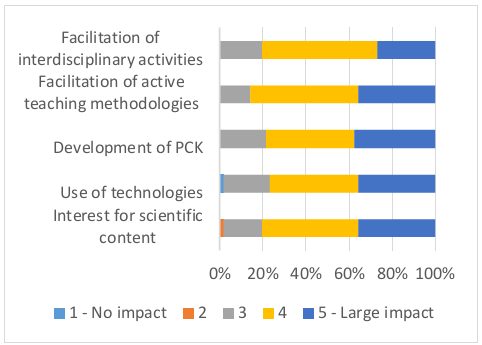
Figure 6. Higher education students' evaluation of the impact of the CreativeLab_Sci&Math ILE on the pedagogical approach experienced.
The results show a high impact of the CreativeLab_Sci&Math ILE on the different features of the pedagogical approach experienced by the students. More than 75% attributed higher values of impact (4 and 5) to all the features inquired. About the interest of this space regarding scientific content, one student considered that “innovative resources [of the CreativeLab_Sci&Math] allow a better understanding of the scientific content” (S2). Another student highlighted in the open question that the “ILE facilitates the interaction between teacher and students” (S10), a consequence of the active teaching methodologies used, centred on the students' work. The facilitation of active teaching methodologies was one of the features with the highest ratings. One aspect that explains that impact is the room layout, as expressed in figure 7.
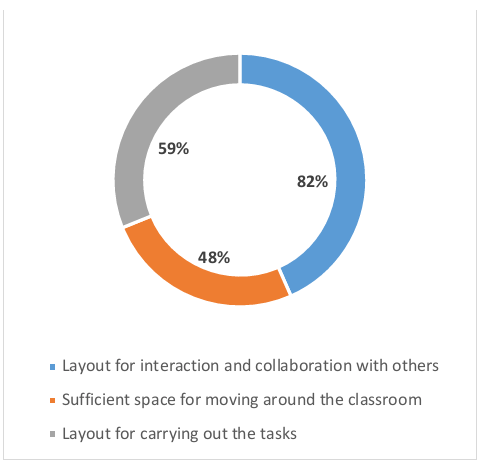
Figure 7. Higher education students' factors used to describe the layout of the CreativeLab_Sci&Math ILE.
More than 80% of students considered the ILE layout was appropriate for interaction with others, while approximately half thought it has sufficient space for moving around and is an appropriate layout for the course tasks proposed. About these factors, one student said: “On the large tables we can do the tasks with more comfort and space” (S4).
DISCUSSION
The findings presented in the previous section suggest a positive perception of the higher education students of the majority of the CreativeLab_Sci&Math attributes pertaining to physical space (temperature, air quality, light, acoustics, visibility, space organization, furniture). Students reported higher satisfaction values to attributes which received lower scores in Yang et al. (2013) such as daylight, air quality, acoustics, and room layout. In fact, in the present study, the students attributed high satisfaction scores to daylight and acoustics. This is quite relevant because Yang et al (2013) stated that lightning and acoustics have a high impact on students' performance. Visibility was also an attribute appreciated by the students inquired in the study carried out by Clinton and Wilson (2019).
However, students attributed lower satisfaction scores to features such as furniture and temperature. Some qualitative answers provided insights into the discomfort caused by some furniture elements, e.g., the chairs. However, the results also demonstrated that students considered these features had only a minor impact on their performance, a perception also aligned with the findings of Yang et al.' (2013) research. Nevertheless, the quality of the seating places is an aspect that deserves further attention in the CreativeLab_Sci&Math because students that use this ILE also reported that the chairs became quite uncomfortable after long periods of time seating on them. The discomfort of seating was also noted in other studies (e.g., Clinton & Wilson, 2019) and could significatively diminish the comfort level of the ILE perceived by students. One strategy that could reduce this discomfort is to alternate tasks performed with students sitting with others that can be performed standing up, for example, some tasks that imply the use of laboratorial equipment.
Concerning the technological attributes (hardware and software), the higher education students were quite satisfied. In fact, the CreativeLab_Sci&Math was equipped during the last years with equipment for facilitating teaching and learning, such as projection equipment or interactive boards. It has also many other resources, such as a large diversity of laboratory equipment and other materials. Recently, it was also equipped with Arduinos, drones and different types of robots for robotics and programming activities. The diversity of resources was noted by one student who commented: “(…) we have at our disposal different resources which allow us a better understanding of the content” (S2). The development of ICTs and related pedagogical practices is a central element of 21st centuries skills development, as stated by Valtonen et al. (2020). These results suggest that an ILE should have diversified technology, but this technology must have a clear pedagogical purpose and effective usage.
The CreativeLab_Sci&Math has a strong focus on innovative educational methodologies. Therefore, in this study a first insight of students' perceptions of the ILE was also evaluated concerning the pedagogical approach they have experienced. The results show high scores in the perceived impact in the use of active teaching methodologies, application of interdisciplinarity activities, development of students' pedagogical content knowledge, use of diversified technologies to support teaching and learning. Students also stated that the ILE promoted their interest for the scientific content addressed. A reason that can explain the previous perception is the investment on a transformation of traditional learning environments into ILEs, a process which characterizes the CreativeLab_Sci&Math ILE. As Merriënboer et al. (2017) emphasized, the successful implementation of educational innovations depends not only on the instructional design but also on the arrangement of the physical environment in which instruction and learning take place. However, as acknowledged at other educational levels, there does not seem to exist a causal link between learning spaces and pedagogical change (Mulcahy et al., 2015). Pedagogical change could be enacted and experienced in ILEs but it is driven by a multiple set of relations and multiple forms of practice (Mulcahy et al., 2015). Therefore, we believe this perception could be the result of the science and mathematics teachers' effort for the creation, implementation, and evaluation of innovative and interdisciplinary activities with a focus on students' work and learning, as highlighted in the ILE learning principles (OCDE, 2017). The current study also suggests that the interaction between teacher and students and the support that teachers give to students in the CreativeLab_Sci&Math is also perceived by them as important for their learning process and outcomes, a relation also presented in similar studies (e.g., Valtonen et al., 2020). The benefit of the ILE's features for students' collaborative learning was also found in other studies (e.g., Borba et al., 2020; Clinton & Wilson, 2019; Rämö et al., 2019; Valtonen et al., 2020). These results suggest that a strong collaboration between teachers, and between teachers and students should characterize the work and the educational approaches of ILEs in higher education.
Some students mentioned that the ILE layout facilitates interaction, such as in this statement: “We are closer to the teacher, and classes are different”. This process of collaboration between teachers and students results in higher levels of student satisfaction and is aligned with the idea put forward by Borba et al. (2020) that “the classroom becomes a collaborative space in the generation of knowledge” (p. 62). It is also aligned with the ILE learning principle which mentions that the nature of learning is social and therefore the learning environment should actively encourage cooperative learning (OECD, 2017). These results suggest that the layout of the ILE should facilitate the movement and the social interaction between teachers and students, with pedagogical purposes. Adding to that idea, Brøns (2020) noticed that is the mobility of people that leads to collaboration, and not the flexibility of the furniture or the architecture.
This study was developed in the context of the COVID-19 pandemic, while strong restrictions of movement and hygiene were in place in all school spaces. Although these circumstances were mentioned in students' comments, we highlight that a student reported the CreativeLab_Sci&Math is “(…) a place where we can safely implement experiments (…)”. This perception could be the result of the layout and the general perception of the hygiene of the space.
Temple (2008) suggested that providing flexible and comfortable spaces could act as part of the learning support. In this study it was also noted that some students considered the space welcoming and warm, which could also contribute to generalized satisfaction with the ILE' attributes. This is probably due to the genuine concern of the CreativeLab_Sci&Math teachers for attending to students' motivations and emotions, which play a key role in the success of learning and should, therefore, be considered in the learning process, according to ILE learning principle three (OECD, 2017).
LIMITATIONS AND FUTURE DIRECTIONS
A limitation of the study is that some students have used the ILE with the constraints imposed by the COVID-19 pandemic, which may have impacted their global appreciation of the attributes of the CreativeLab_Sci&Math. Further research should focus on studying how ILE can better adapt to distance or hybrid (b-learning) learning modalities. In addition to the descriptive statistics carried out in this study, inferential statistics could strengthen the results. Therefore, this complementary approach could be performed on the near future.
One important implication of this work is that it suggests ILEs could have a significative impact on higher education students' satisfaction with the space they use for learning. This initial evidence could be used by other higher education institutions to develop projects of transformation of traditional learning environments into ILEs.
About the impact of school environment on physical education, the lack of modern sport facilities was mentioned in the study of Osokina et al. (2020) as a constraint to physical training of upper secondary students. However, there is a lack of studies in the literature about how the ILE's features impact on physical education in higher education, although some approaches have studied the impact of technology learning environments on physical education teacher education (e.g., Mondaca-Fernandez, 2019). Therefore, the present study could also engage other inquiries about the impact of ILE on physical education.
CONCLUSIONS AND IMPLICATIONS
The purpose of this research was to investigate higher education students' perceptions of the features of the CreativeLab_Sci&Math ILE and the impact on their performance. Globally, students were satisfied with the ILE physical space (temperature, air quality, light, acoustics, visibility, space organization, furniture), technological attributes (hardware and software) and pedagogical approach (active teaching methodologies, interdisciplinarity, pedagogical content knowledge, technologies, and interest in scientific content). These results show that the transformation of the CreativeLab_Sci&Math from a traditional learning environment to an ILE was successful, according to the higher education students' satisfaction survey. These encouraging results could trigger similar space and educational transformations in our and other higher education institutions. However, as Temple (2008) mentioned, we need a better understanding of the role of space in learning and more research about the creation of more productive higher education communities. For example, further research is needed to identify how higher education teachers valued the distinct characteristics of the CreativeLab_Sci&Math ILE, and their impact on teaching.













